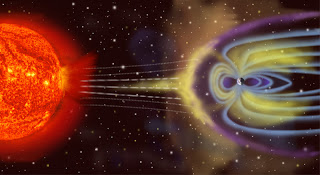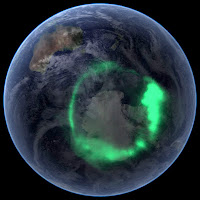Aurorae are one of the most impressive views of a night sky and they are very famous to be an event that not all the skies can host.
They happen around the polar regions, both in the northern and southern hemisphere taking respectively the more common name of northern and southern lights.
The curvy movements and the lightness with which they fly across the sky is a really hypnotizing and fascinating sight that cannot leave even the most apathetic man without a "wow" out of his lips.
[This is a post which is part of the series: 5 unmissable celestial events]
Physical background:
 |
| Impression of how the Solar wind of ionised particles squeezes Earth magnetic field and penetrates throught it. (ionised particles represented in yellow) |
 |
| Sketch showing path of ionised particles in Earth's magnetic field |
What brought life on this planet some time ago, in fact, could destroy life without hesitation using just wind... well a kind of special wind, made of ionized particles. The so-called solar wind is a stream of this highly energetic particles that continually hits the Earth's magnetic field, which, even if deformed by this powerful attack, succeed in protecting the Earth by this harmful radiation... almost.
 |
| Aurorae on Antartica, from space! |
That particles will have a strange fate encountering the Earth's atmosphere: they will combine with atoms and "form light".
If the unlucky particle encounters nitrogen, this atom will go into an excited "energetic" state emitting blue light and re-emitting red light when unexcited. If it encounters oxygen, it will emit green or brown-red light depending on the amount of energy absorbed and re-emitted.
Result:
The result is pretty famous to everyone and these curtains of light moving through a soft wind amaze a lot of lucky people every night somewhere. Thanks, Nature.
Locations:
Around the poles, but can extend further, depending on how strong the solar wind is. On some very rare occasions aurorae have been reported in Europe, USA or Australia. Polar lights are common in countries such as Alaska, Canada, Iceland, Lapland (Norway, Sweden, Finland), Russia, Greenland, Antarctic and rarely in New Zealand, Punta Arenas/Tierra del Fuego (Chile, Argentina). Their length and strength depends on the activity of the Sun.
Interesting Links:
Northern Lights seen from the International Space Station
Aurorae on Jupiter


The wonder of nature.
ReplyDelete